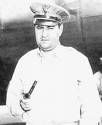By Nick Cullather
Just after 9/11, the United States allegedly threatened to bomb Pakistan “back to the stone age” unless it joined the war on terror. In his new book, Pakistani leader Pervez Musharraf attributes the ultimatum to Richard Armitage, who flatly denies it. Sounding slightly less sure, President Bush says he was “taken aback by the harshness of the words.”
Harsh, maybe, but hardly original. Journalists, fifth-grade bullies, and maybe even diplomats have been worrying that phrase almost as long as “my bad” or “at the end of the day.” If Armitage actually used those words he should be hauled before the International Cliché Tribunal.
The threat’s triteness, however, may offer a clue to its real significance. To become a cliché, a figure of speech has to begin with enough freshness, irony, or dead-on accuracy to get repeated until its original gist wears off. So what did this expression mean, and who said it first?
The quote is usually attributed to Curtis LeMay, the scowling Air Force general who supervised the destruction of Japan’s major cities in World War II and was disappointed when Kennedy wouldn’t let him do the same to Cuba. In his 1968 memoir he suggested that rather than negotiating with Hanoi, the United States should “bomb them back to the stone age,” by taking out factories, harbors, and bridges “until we have destroyed every work of man in North Vietnam.”
LeMay, however, had cribbed it from a June 1967 column by humorist Art Buchwald, who used the phrase to caricature the Goldwater Republican attitude toward Vietnam. The Johnson campaign’s “Daisy Girl” ad, featuring a mushroom cloud and a dark warning about the “stakes” of the 1964 election, had already tarred Republicans as inveterate bombers, but the joke came from Buchwald’s association of bombing with time travel.
Johnson administration insiders also talked of victory as a type of time-shifting. The United States would win over the Vietnamese people by bringing them “into the twentieth century.” Particularly after World War II, U.S. officials tended to rank countries by a single measure, technology, and to express progress in terms of time. Rural, unmechanized countries were feudal, primitive, or backward while industrialized countries, like Britain, lived closer to our time zone, off by maybe a few minutes. Communism’s lumbering one-way march through history was an “alien time sense,” Life magazine explained. Americans treated time like “raw material for whatever project is before us.”
The ability to help friendly countries skip ahead in time by dispensing technology and foreign aid gave Washington a valuable weapon for winning allies. Its controlling vote in the World Bank and multilateral agencies allowed it to decide which countries advanced, and how fast. But there was another strategy deployed in Asia, the one Buchwald lampooned and LeMay advocated. Nations that chose to confront the United States or to pursue revolution instead of development could be wound back like clocks. Twentieth century accoutrements headed the list of bombing targets, and American reconnaissance planes flew regularly and visibly over Pakistan.
The techniques of nation building, in fact, evolved together with theories of aerial bombardment. John Kenneth Galbraith, a development economist and ambassador to India, was a leading figure in the 1945 Strategic Bombing Survey of Germany and Japan. Several economists who pioneered modernization theory in the 1950s—Walt Rostow, Charles P. Kindleberger, and Carl Kaysen—had served during World War II in the Economic Warfare Division of the London embassy as bombing targeters. There they debated how best to dismantle the German economy from the air, whether the whole system had to be taken down together or if there might be specific points—a ball-bearing factory or a refinery—that could be removed, bringing the entire war machine to a halt.
Postwar economists imagined development as a process of dropping in ingredients, and their models deviated, as the targeters had, between “systems” and “bottleneck” approaches. Initially, theorists fell in line behind the notion of “balanced” development, which saddled aid officials with the formidable task of coordinating the simultaneous advance of all social and economic sectors. But after 1960, they fixed their hopes on pinpoint interventions using “epochal” technologies, artifacts capable of advancing a society into a different economic era. In Pakistan, the United States built hydroelectric dams, steel mills, airports, and a small atomic reactor.
Planning for Operation Rolling Thunder in 1965 followed a similar template. Air Force commanders, led by LeMay, favored a “fast, full squeeze” that would target all of North Vietnam’s assets at the beginning of the campaign. But to their frustration, Rostow and other civilian officials opted for a “slow squeeze” involving phased surgical attacks beginning at the DMZ and moving clockwise around Hanoi, gradually spiralling toward the center. This graduated response would convey an implied threat. Vietnam’s factories, urban centers, hospitals, and ports were hostage to Washington’s judgment. By the time that Rolling Thunder was terminated in 1968, North Vietnam had been heavily bombed but the goal of forcing termination of NLF activities in the South was as elusive as ever. Other Asian leaders received the same message in subtler form. When Ayub Khan, the Pakistani prime minister, visited Washington in 1966, Johnson presented him a framed color photograph of his country, cities clearly visible, taken from an American rocket.
Leaders of Musharraf’s generation grew up identifying the United States with the excitement, speed, and energy of modern technology, while also being conscious that America felt it owned modernity, that it had a right to decide who lived in the future, and who in the past. Armitage may never have said anything about the stone age, but when he phoned in September 2001 to ask if Pakistan was on our side, Musharraf heard the assertion of an old prerogative. Washington was calling to tell him what time it was.
Nick Cullather is a professor of history at Indiana University and a coauthor of Making of a Nation: The United States and Its People, Student Edition.







